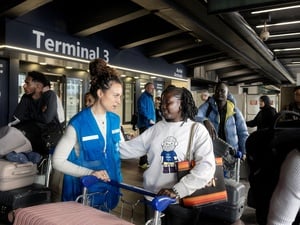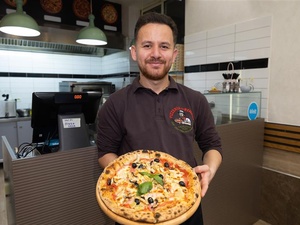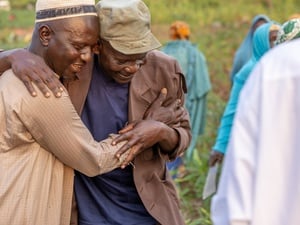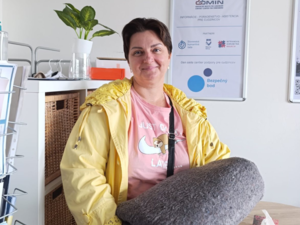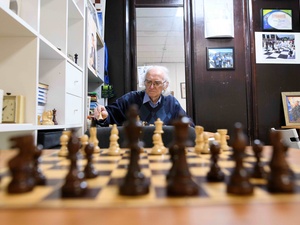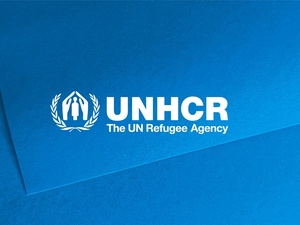Yuliia: “I’m still in awe. Budapest inspires me every single day."
Yuliia: “I’m still in awe. Budapest inspires me every single day."

Yuliia holds a photo of her family. When she fled Ukraine, she did not have time to take the picture frame with her. It was the first thing she requested to be sent to her in Budapest and she sees it as a symbol of hope.
“When Russia invaded Ukraine on 24 February 2022, the following day at 8 am I left Kyiv with my friends. Initially, we were not planning to leave, we just wanted to find a safe shelter from the bombs and missiles in the metro. On our way there, however, we learned that Russian helicopters were approaching Kyiv, likely with troops to be airdropped to the city. At that moment, it struck me that Kyiv might be surrounded and taken. We realized the situation was becoming critical and that staying in the city was dangerous. It felt like if we didn’t leave right away, we might not get another chance.
Fleeing Kyiv was scary. We knew that people were shot in their cars on the roads and had no idea which direction would be safe. I called a friend, who confirmed that the highway leading out from the city through Obukhiv, a suburban town south of Kyiv, was still clear.
We hit the road and started thinking about where we could go only when we were already driving. There were four of us, my friends and me. In the car I felt as if I were in an American action movie where something terrible was happening. I could only think about one thing: why people in those movies are never afraid. Me, on the contrary, I was so scared, my whole body was shaking and trembling and could not calm down. We were afraid that rockets could hit anytime and anywhere and kept looking up at the sky to make sure there were no planes or helicopters.
With a couple of calls, we learned that my hometown, Kropyvnytskyi, 300 kilometres to the southeast from Kyiv, was not an option. They were expecting Russian troops landing in that area, too. By today, we know it was just rumours, but back then we didn’t want to take any chances.
This is how after a 220-kilometre-long stressful journey we ended up in the tiny village of Dibrovintsy in the Orativ district, close to the city of Vinnytsia, where my friend’s grandmother lived. We just needed to get to a safe place, and a small village felt much safer than the capital. I ended up in the home of a local family there. I had not known these people before, but in those fearful days, they became like family to me.
Each air raid alarm, however, drove me into a strong panic. I was constantly afraid that a missile could hit anywhere, and my life could end. So, I decided it would be better for my mental health if I left the country. It was on 8 March, on International Women’s Day, I remember, when I realised, I could not stay there any longer. Two weeks later, we hit the road again and arrived in Hungary in the middle of the night from 21 March to 22 March at the border crossing village Vylok on the Ukrainian side. We crossed the Tisza river and arrived in the village of Tiszabecs on the Hungarian side. By that time, the first big wave of refugees had already passed, there were only some two or three cars at the checkpoint at midnight, so we managed to get through quickly.
The border guards on both the Ukrainian and Hungarian sides were very kind, understanding, and helpful. We were truly thankful to them. Also, upon arriving in Budapest, one of my friends found some local volunteers who kindly and generously helped us with accommodation. For the first two months we lived in a place for free, only had to pay for the utilities.

Why Hungary and why Budapest?
It was an absolutely logical choice for me. I had friends living here and understood that, especially in my emotional and mental state that time, I needed to live in a city where I knew somebody and where somebody knew me. When I arrived in Budapest, however, it was love at first sight. I’m someone who is deeply influenced by aesthetic beauty, and this city felt truly magical. It is incredibly beautiful, with breathtaking architecture that instantly captured my heart. Now I’ve been living here for over three years, and I’m still in awe. Budapest inspires me every single day.
I came to Hungary without my family. My sister Anya was in the seventh month of her pregnancy when the Russian invasion began, so she and her husband, could not travel. Soon after she gave birth to her son, they followed me to Hungary with their newborn baby. Today, we live all together, the four of us, in Budapest.
As for my life before the war, I lived in Kyiv for the last ten years and worked there as a producer at a TV channel on different programs like social talk shows, reality shows and other entertainment programs, with the Top Model of Ukraine being probably the best known of them. I also did a huge live dancing show with 500 dancers on the stage through several seasons for “Inter”, one of the biggest TV channels in Ukraine. The title of this show was a mixed Ukrainian-English play on words: “Maidan’s”. We took the name of Kyiv’s famous central square, added the letter “s” to it, and if you try it with an English pronunciation, what you get is: “My Dance”.
When I arrived in Budapest, it soon became clear to me that a lot of movies are shot in Hungary. Not only local productions, but foreign ones, too, including big budget Hollywood films. I joined a Hungarian production company in June 2022, which shoots music videos. In addition, I am also involved in several Hungarian productions. I have produced a pilot for a series, filmed a series in Ukraine, and work on a Ukrainian-Polish feature film co-production titled “House of Europe”. We plan to film most of the scenes in Hungary.
We also won a grant from a French national TV channel for a Ukrainian documentary TV series. It is called “Carlos in Ukraine”. I am the executive producer and the whole concept is based on my idea. The story is about an American journalist who decided to go to Ukraine after the full-scale war started in 2022, and film his own documentary about how ordinary people live in Ukraine in the time of war.
My top goal today, however, is even more ambitious. I have started working on the creation of a charitable organization that would focus on vital social projects through video production. Video will be the impactful tool for talking about pressing social issues that are relevant across the globe. Now, we are at the stage of trying to get the first project off the ground. It is a social impact project centring around a short film on refugee women across the world that tells their story in the language of dance. Based on this dance film we plan to launch a large global social campaign to raise money to help refugee women with children. Another project idea is to show how volunteers work and support people. Hopefully, we will be able to raise enough money and help a lot of these volunteer organisations at the end. At the moment, I am looking for funding for these two projects.
Hungary is really a great country. I like the landscape, the city, the culture, everything. Of course, by now, I have realised that Hungarian language is a very difficult one. I try to learn it, but it is so difficult. Still, when I arrived here, I didn’t speak either English or Hungarian. This hugely limited my ability to communicate, and my opportunities in everyday life. It was a challenge to build connections and find people who could support me. I am deeply grateful to those people who helped me back then. They became very close to me – and will remain forever.”
ABOUT THE ITEM YULIIA IS PHOTOGRAPHED WITH:
“This photo frame used to sit in my apartment in Kyiv. When I fled, I asked for it to be sent to me almost immediately, since to me, it’s more than just a photo. It’s a symbol of our family, of connection and love. In the picture are my mom, my sister, and me. Friends brought it to me to Hungary from Ukraine, and it has been with me ever since. For many years now, it has reminded me of home, of the people I love, and of what truly matters.”


